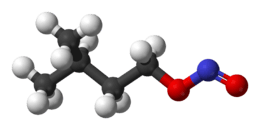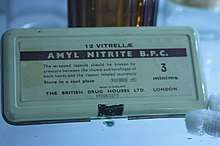Amyl nitrite
Amyl nitrite is a chemical compound with the formula C5H11ONO. A variety of isomers are known, but they all feature an amyl group attached to the nitrite functional group. The alkyl group is unreactive and the chemical and biological properties are mainly due to the nitrite group. Like other alkyl nitrites, amyl nitrite is bioactive in mammals, being a vasodilator, which is the basis of its use as a prescription medicine. As an inhalant, it also has a psychoactive effect, which has led to its recreational use with its smell being described as that of old socks or dirty feet.[1] It is also referred to as banapple gas.[2]
 | |
 | |
| Clinical data | |
|---|---|
| Other names | Isoamyl nitrite, Nitramyl, 3-methyl-1-nitrosooxybutane, Pentyl alcohol nitrite (ambiguous), poppers (colloquial, slang) |
| ATC code | |
| Identifiers | |
| |
| CAS Number | |
| PubChem CID | |
| DrugBank | |
| ChemSpider | |
| UNII | |
| KEGG | |
| ChEBI | |
| CompTox Dashboard (EPA) | |
| Chemical and physical data | |
| Formula | C5H11NO2 |
| Molar mass | 117.148 g·mol−1 |
| 3D model (JSmol) | |
| Density | 0.872 g/cm3 |
| Boiling point | 99 °C (210 °F) |
| Solubility in water | Slightly soluble mg/mL (20 °C) |
| |
| |
| (verify) | |
It was first documented in 1844 and came into medical use in 1867.[3]
Uses
- Amyl nitrite is employed medically to treat heart diseases as well as angina.
- Amyl nitrite is sometimes used as an antidote for cyanide poisoning.[4][5] It can act as an oxidant, to induce the formation of methemoglobin. Methemoglobin in turn can sequester cyanide as cyanomethemoglobin.[6]
- Amyl nitrite is used as a cleaning agent and solvent in industrial and household applications. It replaced dichlorodifluoromethane, an industrial chemical universally banned in 1996 due to damage to the ozone layer,[7] as a printed circuit board cleaner. A very small amount is added to some perfumes.[8]
- It is also used recreationally as an inhalant drug that induces a brief euphoric state, and when combined with other intoxicant stimulant drugs such as cocaine or MDMA, the euphoric state intensifies and is prolonged. Once some stimulative drugs wear off, a common side effect is a period of depression or anxiety, colloquially called a "come down"; amyl nitrite is sometimes used to combat these negative after-effects. This effect, combined with its dissociative effects, has led to its use as a recreational drug (see poppers).[4]
Nomenclature
The term "amyl nitrite" encompasses several isomers. For example, a common form of amyl nitrite with the formula (CH3)2CHCH2CH2ONO may be more specifically referred to as isoamyl nitrite. When the amyl group is a linear or normal (n) alkyl group, the resulting amyl nitrite would have the structural formula CH3(CH2)4ONO.
The similarly-named amyl nitrate has very different properties. At the same time, isopropyl nitrite has a similar structure and similar uses (also called 'poppers') but with worse side-effects.
Synthesis and reactions
Alkyl nitrites are prepared by the reaction of alcohols with nitrous acid:[9]
- ROH + HONO → RONO + H2O, where R = alkyl group
The reaction is called esterification. Synthesis of alkyl nitrites is, in general, straightforward and can be accomplished in home laboratories. A common procedure includes the dropwise addition of concentrated sulfuric acid to a cooled mixture of an aqueous sodium nitrite solution and an alcohol. The intermediately-formed stoichiometric mixture of nitrogen dioxide and nitric oxide then converts the alcohol to the alkyl nitrite, which, due to its low density, will form an upper layer that can be easily decanted from the reaction mixture.
Isoamyl nitrite decomposes in the presence of base to give nitrite salts and the isoamyl alcohol:
- C5H11ONO + NaOH → C5H11OH + NaNO2
Amyl nitrite, like other alkyl nitrites, reacts with carbanions to give oximes.[10]
Amyl nitrites are also useful as reagents in a modification of the Sandmeyer reaction. The reaction of the alkyl nitrite with an aromatic amine in a halogenated solvent produces a radical aromatic species, this then frees a halogen atom from the solvent. For the synthesis of aryl iodides diiodomethane is used,[11][12] whereas bromoform is the solvent of choice for the synthesis of aryl bromides.[13]
Physiological effects

Amyl nitrite, in common with other alkyl nitrites,[14] is a potent vasodilator; it expands blood vessels, resulting in lowering of the blood pressure. Amyl nitrite may be used during cardiovascular stress testing in patients with suspected hypertrophic cardiomyopathy to cause vasodilation and thereby reduce afterload and improve an otherwise acute left ventricular outflow tract obstruction. Alkyl nitrites are a source of nitric oxide, which signals for relaxation of the involuntary muscles. Physical effects include decrease in blood pressure, headache, flushing of the face, increased heart rate, dizziness, and relaxation of involuntary muscles, especially the blood vessel walls and the internal and external anal sphincter. There are no withdrawal symptoms. Overdose symptoms include nausea, vomiting, hypotension, hypoventilation, shortness of breath, and fainting. The effects set in very quickly, typically within a few seconds and disappear within a few minutes. Amyl nitrite may also intensify the experience of synesthesia.[15]
References
- "Drugs - Amyl, Butyl or Isobutyl Nitrite, Nitrates, Poppers". urban75.com.
- Nordegren T (2002). The A-Z Encyclopedia of Alcohol and Drug Abuse. Brown Walker Press. p. 94. ISBN 158112404X. Retrieved 5 February 2017.
- Fischer J, Ganellin CR (2006). Analogue-based Drug Discovery. John Wiley & Sons. p. XXX. ISBN 9783527607495.
- AJ Giannini, AE Slaby, MC Giannini. The Handbook of Overdose and Detoxification Emergencies. New Hyde Park, NY. Medical Examination Publishing Co., 1982, pp.48-50.
- Mason DT, Braunwald E (November 1965). "The effects of nitroglycerin and amyl nitrite on arteriolar and venous tone in the human forearm". Circulation. 32 (5): 755–66. doi:10.1161/01.cir.32.5.755. PMID 4954412.
- Vale, J. A. (2001). "Cyanide Antidotes: from Amyl Nitrite to Hydroxocobalamin – Which Antidote is Best?". Toxicology. 168 (1): 37–38.
- "Dichlorodifluoromethane at LearnChemistry (Royal Society of Chemistry)".
- "Generic Amyl Nitrite for Purchase". amylnitrite.org.
- Noyes WA (1943). "n-Butyl Nitrite". Organic Syntheses.; Collective Volume, 2, p. 108
- Chen YK, Jeon SJ, Walsh PJ, Nugent WA (2005). "(2S)-(−)-3-exo-(Morpholino)isoborneol ((−)-MIB)". Organic Syntheses. 82: 87.
- Smith WB, Ho OC (1990). "Application of the isoamyl nitrite-diiodomethane route to aryl iodides". The Journal of Organic Chemistry. 55 (8): 2543–2545. doi:10.1021/jo00295a056.
- Cornforth J, Kumar A, Stuart AS (1987). "Synthesis of substituted dibenzophospholes. Part 6. Preparation of symmetrical and non-symmetrical quaterphenyl intermediates". Journal of the Chemical Society, Perkin Transactions 1: 859. doi:10.1039/P19870000859.
- Cadogan JI, Roy DA, Smith DM (1966). "An alternative to the Sandmeyer reaction". Journal of the Chemical Society C: Organic: 1249. doi:10.1039/J39660001249.
- Nickerson M, Parker JO, Lowry TP, Swenson EW (1979). Isobutyl Nitrite and Related Compounds (PDF) (1st ed.). San Francisco California: PHARMEX. Archived from the original (PDF) on 2007-09-27.
- Richard Cytowic, The Man Who Tasted Shapes, 2003.
Further reading
- Kjonaas RA (1996). "Amyl: A Misunderstood Word". Journal of Chemical Education. 73 (12): 1127. Bibcode:1996JChEd..73.1127K. doi:10.1021/ed073p1127. Editorial on the use of the word "amyl".